Patricia J. Culligan
Urban Infrastructure
City Green, Coastal Green
With more rooftops than green space, the topography of major cities interferes with the natural exchange of precipitation between land, water bodies, and the atmosphere. When it rains in a city, some water evaporates, very little seeps into the ground, and the rest runs off to drains where it enters the sewer system. Even during small rainfall events, sewer and water treatment systems can be overpowered, carrying pollution straight into nearby rivers and streams. This off-kilter hydrologic cycle detrimentally impacts coastal zones, which end up receiving concentrated pollutants and excess nutrients.
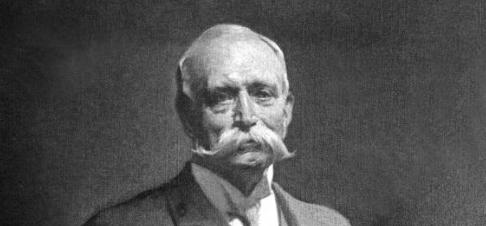
Safety First
Charles F. Chandler
Cofounder
Charles F. Chandler (1836– 1925), who cofounded Columbia’s School of Mines in 1864, was a fervent champion for public health reform in New York City.
Appointed the City’s first chemist of the Board of Health in 1867, Chandler fought dairy interests and the widespread practice of milk adulteration. He also examined impurities in the City’s water supply, advocating for clean and safe drinking water. And in an attempt to control the spread of disease, he promoted vaccination. Dedicated to raising awareness about the significance of public health, he pioneered instilling public health standards, including mandating indoor plumbing.
In 1873, Chandler was appointed president of the New York Metropolitan Board of Health and quickly became a leading authority on many matters of public health. He also established flash-point tests for kerosene, reducing the problem of lamp explosions, and with his campaign for vaccinations, particularly during the 1870s smallpox outbreak, he helped reduce the annual child death rate significantly.
Chandler’s tenure at Columbia spanned more than 50 years. In 1864, he was appointed a professor at the University’s new School of Mines and shortly after, served as its first dean, a position he held for 33 years. He founded the Chemistry Department and served as its inaugural chair from 1866 to 1903.
An industrial chemist, Chandler taught courses in chemistry, geology, and mineralogy. With his connection as a consultant to the Havemeyer family’s American Sugar Refining Company, Chandler was instrumental in the construction of a new campus building devoted to chemistry: Havemeyer Hall. As the Engineering School’s first dean, Chandler led its early beginnings as a leader in mining and metallurgy research and education, and oversaw the growth of the School’s student body and distinguished faculty.
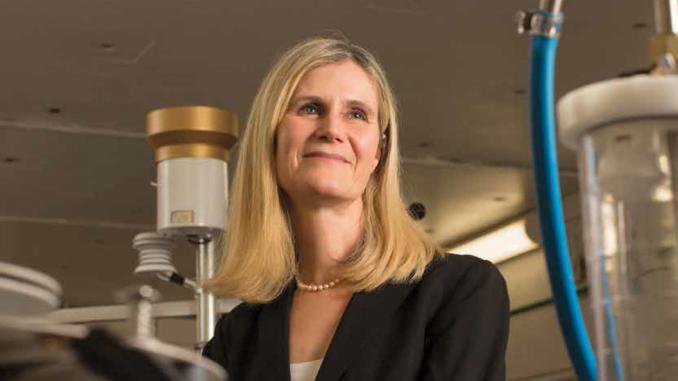
Patricia J. Culligan
Culligan’s fascination with green roof technology combines her experience in civil engineering and soil mechanics with her desire to solve the challenges associated with dense urban environments. “Through engineering we can solve challenges that affect life, through thoughtful and collaborative design,” she says.
Many cities are turning to green roof technology to help mitigate the effects of runoff on coastal zones. But green roofs are only one part of a high-performance green infrastructure.
“We think about highly engineered systems—how the plants, the growing medium, the foundation—can all work together to not only prevent runoff but also filter out pollutants and nutrients. We think about how the water can be stored to re-irrigate the vegetation growing on the roof and how that can promote evapotranspiration,” she says. “We want to design green infrastructure that can enhance human health, result in economic efficiency, and reduce pollution.”
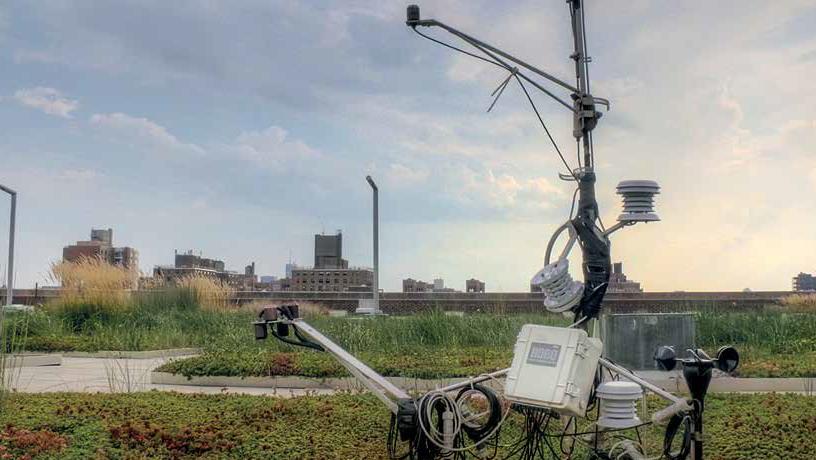
A green roof weather station.
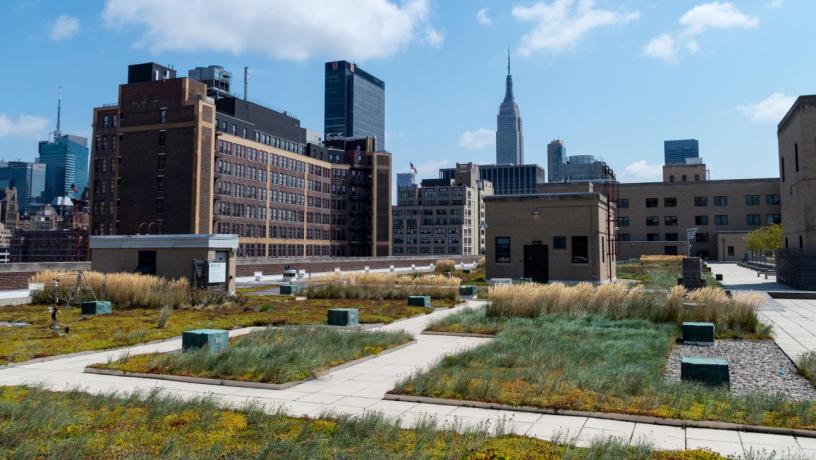
The USPS building in Midtown Manhattan, one of the green roofs being monitored by Culligan’s team.
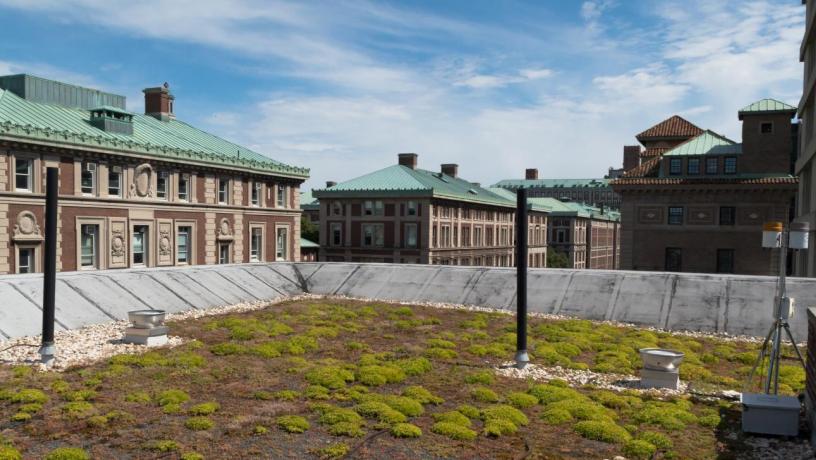
Columbia campus green roof (weather station visible at the bottom right).
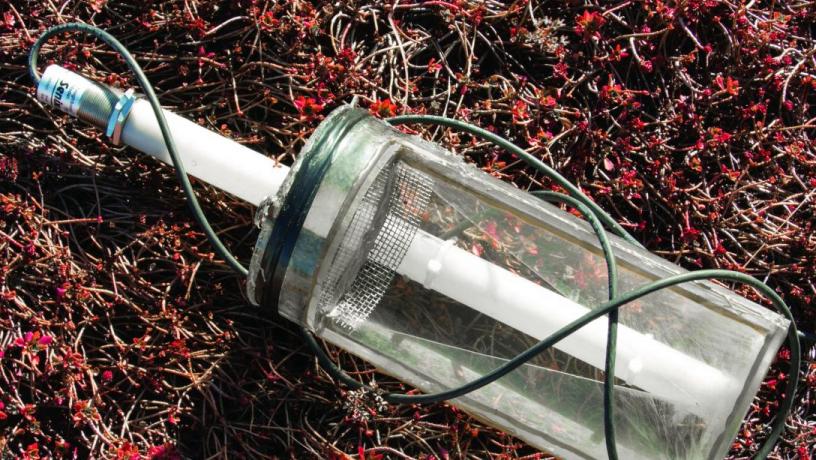
Equipment deployed on green roofs to measure their ability to mitigate stormwater runoff.
Her goal is well aligned with those of coastal cities around the world. With the help of a newly secured five-year, $3 million grant from the National Science Foundation, Culligan is leading a team of 20 investigators to study how high-performance green infrastructure can mitigate a city’s impact on coastal pollution. They plan to monitor dozens of sites, including green streets, tree pits, green roofs, and bioswales that impact the Bronx River. At the same time, they plan to collect data about stormwater flow, air, surface and substrate temperatures, substrate moisture content, and water quality and pollutants. Her team’s work is expected to contribute to New York State’s and New York City’s $2.7 billion investment in high-performance green infrastructure over the next 20 years.
“We are excited that our work has potential to inform how New York and other large cities near coastlines can best invest in green infrastructure to make the most difference in improving the health of coastal zones,” Culligan says.
The problem with urban runoff and its effects on human health and the environment is not new. In the late 19th century, Columbia Engineering’s dean, Charles F. Chandler, became an energetic public health advocate and sanitation reformer. His reforms included enactment of building codes with adequate provisions for indoor plumbing, which he personally designed with appropriate trapping systems. Many of his reforms became national models.
“Like Chandler, it is our obligation as engineers to expand our roles in order to make our world healthier,” Culligan says. “If we are serious about sustainability, we must be serious in collaborating with other disciplines besides engineering, such as public health, social science, and economics, in order to make informed decisions. Improving the environment is no longer just about meeting performance goals but maximizing societal and economic impact as well.”
“In order to rebalance the hydrologic cycle in urban environments, we need to introduce more vegetation,” says Patricia J. Culligan, professor of civil engineering and engineering mechanics. “Typically, 40 percent of the land area in a city is rooftops, so green roof technology has become a popular way to help establish more vegetation in urban environments.”
Culligan is principal investigator for the Columbia Green Roof Consortium and is charged with comparing and evaluating the effectiveness of different green roof technologies for use on campus and city buildings. The Consortium, which conducts research on one of New York City’s largest networks of green roof research stations, has been active in engaging high school students, undergraduates, and graduate research assistants in its monitoring efforts.
“The opportunity to advance this important work is exciting training for our students, who are able to leverage what they learn in the classroom with researching in the field,” says Culligan, who also serves as associate director of Columbia’s Institute for Data Sciences and Engineering.
